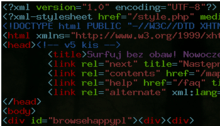XHTML/What is XHTML
< XHTMLExtensible Hypertext Mark Up Language (XHTML) is the successive markup language to the near ubiquitous Hypertext Mark Up Language (HTML). Rooted in Standard Generalized Markup Language (SGML), HTML is flexible but complex, leaving the liberties with which web browsers take with its rules to cause a number of problems. Based on the strict and simple Extensible Markup Language (XML) standard, XHTML aims to resolve said problems while offering extensibility with other XML-based applications. In summation, XHTML is HTML rewritten to comply with XML, hence its name.
XHTML, being a subset of XML, will also be extensible to other XML applications and featured. For example, it may also include fragments from other XML based languages, such as Scalable Vector Graphics or MathML through the usage of namespaces.
What HTML Stands For
The abbreviation of HTML stands for HyperText Mark-Up Language. Explained in more detail, this means:
- H (Hyper): The opposite of linear. Instead of going from the first line to the following one, the decision in where and when everything is set is up to the programmer (Specifically, you.).
- T (Text): This one is self-explanatory. The programming language is created through text.
- M (Mark-Up): This is what you can do with the text; you can mark-ups to edit a text's style, such as boldness, headings, bullets, and so on.
- L (Language): Also self-explanatory. HTML is a programming language.
The Components
An XHTML document is made up of four main components:
- Document Type Definition (DTD): This used to be optional in HTML, but it is compulsory in XHTML. The DTD describes the language or script in which the text has been encoded.
- Text content: the headers and paragraphs that appear on the page.
- References: Advanced content like links and images.
- Mark-Up: Instructions on how the content should be displayed.
Each of these components is comprised of text. This means that the page can be saved in text format and viewed in any browser.
XHTML stands for extensible Hypertext Markup Language. It is a different version of HTML, it is based off of XML. XHTML is used to make webpages and has a very specific way to be written to be correct and without error. XHTML is also very case-sensitive. the tags are written in lowercase and need to be closed.The order of the tags also need to be in correct order for the information to come out correct. there are three main sections of XHTML consist of A declaration statement, a Head statement and a body.
 XHTML
XHTML